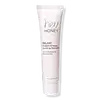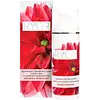What's inside
What's inside
 Key Ingredients
Key Ingredients

 Benefits
Benefits

 Concerns
Concerns

 Ingredients Side-by-side
Ingredients Side-by-side

Water
Skin ConditioningCaprylic/Capric Triglyceride
MaskingAlcohol
AntimicrobialSorbitol
HumectantCetyl Alcohol
EmollientGlyceryl Stearate
EmollientGlycerin
HumectantHoney Extract
HumectantLonicera Japonica Flower Extract
Skin ConditioningSodium Polyacrylate
AbsorbentTocopheryl Acetate
AntioxidantSodium Stearoyl Glutamate
CleansingPropolis Extract
Skin ConditioningPhenethyl Alcohol
MaskingCimicifuga Racemosa Root Extract
AntimicrobialAloe Barbadensis Leaf Juice Powder
Skin ConditioningLactic Acid
BufferingLonicera Caprifolium Flower Extract
PerfumingWater, Caprylic/Capric Triglyceride, Alcohol, Sorbitol, Cetyl Alcohol, Glyceryl Stearate, Glycerin, Honey Extract, Lonicera Japonica Flower Extract, Sodium Polyacrylate, Tocopheryl Acetate, Sodium Stearoyl Glutamate, Propolis Extract, Phenethyl Alcohol, Cimicifuga Racemosa Root Extract, Aloe Barbadensis Leaf Juice Powder, Lactic Acid, Lonicera Caprifolium Flower Extract
Water
Skin ConditioningDiethylhexyl Carbonate
EmollientPersea Gratissima Oil
Skin ConditioningCaprylic/Capric Triglyceride
MaskingGlycerin
HumectantIsohexadecane
EmollientTocopheryl Acetate
AntioxidantSimmondsia Chinensis Seed Oil
EmollientAloe Barbadensis Leaf Juice Powder
Skin ConditioningSodium Hyaluronate
HumectantSodium Acrylate/Sodium Acryloyldimethyl Taurate Copolymer
Emulsion StabilisingPolysorbate 80
EmulsifyingOleyl Erucate
EmollientPhenoxyethanol
PreservativeCetyl Alcohol
EmollientIsostearyl Isostearate
EmollientCetyl Stearate
EmollientStearic Acid
CleansingSodium Caproyl Prolinate
HumectantPolyacrylate Crosspolymer-6
Emulsion StabilisingPotassium Cetyl Phosphate
EmulsifyingDicetyl Phosphate
EmulsifyingGlyceryl Laurate
EmollientLactic Acid
BufferingParfum
MaskingBenzyl Salicylate
PerfumingHexyl Cinnamal
PerfumingWater, Diethylhexyl Carbonate, Persea Gratissima Oil, Caprylic/Capric Triglyceride, Glycerin, Isohexadecane, Tocopheryl Acetate, Simmondsia Chinensis Seed Oil, Aloe Barbadensis Leaf Juice Powder, Sodium Hyaluronate, Sodium Acrylate/Sodium Acryloyldimethyl Taurate Copolymer, Polysorbate 80, Oleyl Erucate, Phenoxyethanol, Cetyl Alcohol, Isostearyl Isostearate, Cetyl Stearate, Stearic Acid, Sodium Caproyl Prolinate, Polyacrylate Crosspolymer-6, Potassium Cetyl Phosphate, Dicetyl Phosphate, Glyceryl Laurate, Lactic Acid, Parfum, Benzyl Salicylate, Hexyl Cinnamal
Ingredients Explained
These ingredients are found in both products.
Ingredients higher up in an ingredient list are typically present in a larger amount.
Aloe Barbadensis Leaf Juice Powder comes from the aloe plant.
You may know Aloe to be a good sunburn reliever and inflammation reducer. This is because it contains many components that are known to help reduce irritation and itchiness.
Aloe leaves are also great moisturizers. They are naturally rich in polysaccharides, a carbohydrate made of sugars. Polysaccharides are able to mimic the carbs found in the top layer of your skin. This can help keep your skin hydrated.
Aloe contains the antioxidants Vitamins A, C, and E. These vitamins neutralize free radicals. Free-radicals are molecules that may damage your skin cells, such as pollution.
Aloe does not protect against UV rays, despite it soothing sunburns.
Learn more about Aloe Barbadensis Leaf Juice PowderThis ingredient is an emollient, solvent, and texture enhancer. It is considered a skin-softener by helping the skin prevent moisture loss.
It helps thicken a product's formula and makes it easier to spread by dissolving clumping compounds.
Caprylic Triglyceride is made by combining glycerin with coconut oil, forming a clear liquid.
While there is an assumption Caprylic Triglyceride can clog pores due to it being derived from coconut oil, there is no research supporting this.
Learn more about Caprylic/Capric TriglycerideCetyl Alcohol is a fatty alcohol. Fatty Alcohols are most often used as an emollient or to thicken a product.
Its main roles are:
Though it has "alcohol" in the name, it is not related to denatured alcohol or ethyl alcohol.
The FDA allows products labeled "alcohol-free" to have fatty alcohols.
Learn more about Cetyl AlcoholGlycerin is already naturally found in your skin. It helps moisturize and protect your skin.
A study from 2016 found glycerin to be more effective as a humectant than AHAs and hyaluronic acid.
As a humectant, it helps the skin stay hydrated by pulling moisture to your skin. The low molecular weight of glycerin allows it to pull moisture into the deeper layers of your skin.
Hydrated skin improves your skin barrier; Your skin barrier helps protect against irritants and bacteria.
Glycerin has also been found to have antimicrobial and antiviral properties. Due to these properties, glycerin is often used in wound and burn treatments.
In cosmetics, glycerin is usually derived from plants such as soybean or palm. However, it can also be sourced from animals, such as tallow or animal fat.
This ingredient is organic, colorless, odorless, and non-toxic.
Glycerin is the name for this ingredient in American English. British English uses Glycerol/Glycerine.
Learn more about GlycerinLactic Acid is another well-loved alpha hydroxy acid (AHA). It is gentler than glycolic acid but still highly effective.
Its main role is to exfoliate the surface of the skin by loosening the “glue” that holds dead skin cells together. Shedding those old cells leads to smoother, softer, and more even-toned skin.
Because lactic acid molecules are larger than glycolic acid, they don’t penetrate as deeply. This means they’re less likely to sting or irritate, making it a great choice for beginners or those with sensitive skin.
Like glycolic acid, it can:
Lactic acid also acts as a humectant (like hyaluronic acid). It can draw water into the skin to improve hydration and also plays a role in the skin's natural moisturizing factor (NMF) in the form of sodium lactate.
Studies show it can boost ceramide production to strengthen the skin barrier and even help balance the skin’s microbiome.
To get results, choose products with a pH between 3-4.
Lower strengths (5-12%) focus on surface exfoliation; higher strengths (12% and up) can reach deeper in the dermis (deeper, supportive layer) to improve skin texture and firmness over time.
Though it was originally derived from milk, most modern lactic acid used in skincare is vegan. It is made through non-dairy fermentation to create a bio-identical and stable form suitable for all formulations.
When lactic acid shows up near the end of an ingredient list, it usually means the brand added just a tiny amount to adjust the product’s pH.
Legend has it that Cleopatra used to bathe in sour milk to help reduce wrinkles.
Lactic acid is truly a gentle multitasker: it exfoliates, hydrates, strengthens, and brightens. It's a great ingredient for giving your skin a smooth, glowing, and healthy look without the harshness of stronger acids.
Read more about some other popular AHA's here:
Learn more about Lactic AcidTocopheryl Acetate is AKA Vitamin E. It is an antioxidant and protects your skin from free radicals. Free radicals damage the skin by breaking down collagen.
One study found using Tocopheryl Acetate with Vitamin C decreased the number of sunburned cells.
Tocopheryl Acetate is commonly found in both skincare and dietary supplements.
Learn more about Tocopheryl AcetateWater. It's the most common cosmetic ingredient of all. You'll usually see it at the top of ingredient lists, meaning that it makes up the largest part of the product.
So why is it so popular? Water most often acts as a solvent - this means that it helps dissolve other ingredients into the formulation.
You'll also recognize water as that liquid we all need to stay alive. If you see this, drink a glass of water. Stay hydrated!
Learn more about Water